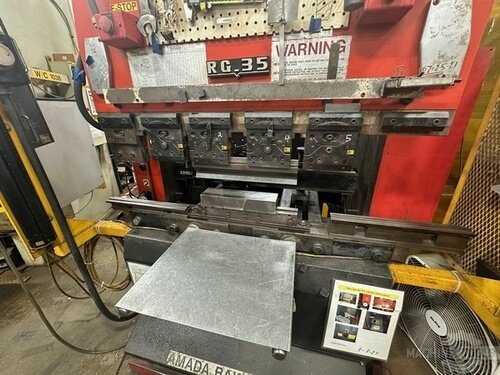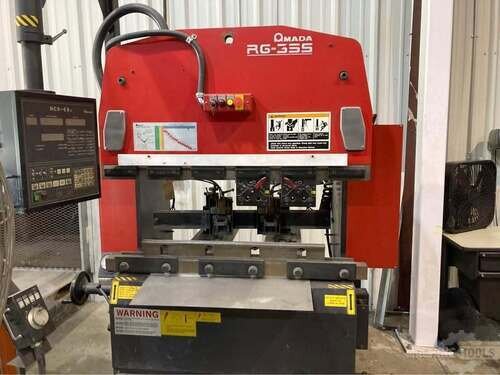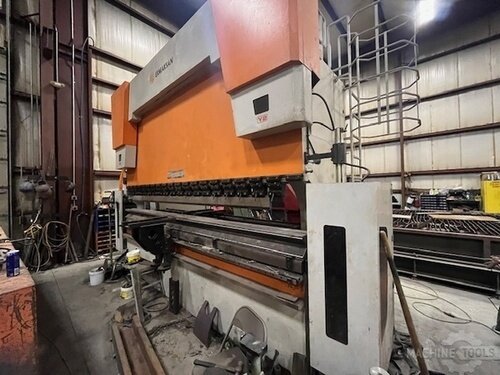Ermaksan High-Tonnage Press Brakes: No Bottlenecks, 2025 Section 179 Expensing
I am Joe Ryan, President of Mac-Tech. My job is to help metal fabrication leaders align capital equipment with throughput goals, profitability targets, and resilient operations. High-tonnage forming is often where work-in-process slows and margins slip. Ermaksan high-tonnage brakes unlock capacity without bottlenecks and, with Section 179 eligibility, can be fully expensed in 2025 subject to limits. My team guides you from business case to turnkey integration so your investment translates to faster flow, lower cost per bend, and measurable cash returns.
Eliminate Forming Bottlenecks with Ermaksan High-Tonnage Precision and Intelligent Automation
Large and thick parts can overwhelm conventional brakes. Ermaksan high-tonnage systems are engineered for stable force delivery, precise ram repeatability, and consistent bend angles across long flanges. With servo-hydraulic control, CNC crowning, and 6 to 18 axis backgauges, they hold tolerance on heavy gauge components while reducing rework. Bed lengths and throat depths are configured for your largest blanks, with sheet followers to support weight and maintain cycle speed.
Accuracy flows from the control stack. Delem and ESA controllers provide 2D and 3D bend simulation, collision checks, and automatic bend sequencing that minimize regrips. Real-time angle control, hydraulic clamping compatible with Wila and Promecam tooling, and robust frames that resist deflection ensure first-part-right runs. The result is predictable cycle times that remove forming as a gating step for downstream weld and assembly.
Scale Without Adding Shifts: Tandem, Long-Bed, and Robotic Cells for Large-Part Throughput
When parts exceed a single bed length, Ermaksan tandem configurations synchronize two brakes to operate as one long machine or independently. This lets you bend 20 to 40 foot components, then split back into two stations for regular work. Long-bed, high-tonnage units reduce setups for large housings, panels, and beams, eliminating workarounds that burn hours and introduce risk.
For repeat heavy parts, robotic bending cells keep operators out of the pinch point and maintain consistent takt time on thick material. Paired with sheet followers or frontgauge automation, the robot handles weight, the brake manages precision, and the operator supervises multiple machines. You gain throughput without adding shifts. Lights-out or lights-dim operation becomes realistic when parts and tools are standardized and changeovers are orchestrated with offline programs.
ERMAKSAN POWER-BEND FALCON BENDING MACHING
ERMAKSAN SPEED BEND PRO
The Financial Model Executives Need: Cost per Bend, OEE Gains, and a CapEx to Cash Flow Timeline
Your board approves what they can model. We build a cost per bend analysis that captures financing or depreciation, labor, setup time, scrap, tooling, energy, and maintenance. On high-tonnage work, the big wins come from fewer regrips, faster setups, and less scrap. That lifts OEE by attacking availability, performance, and quality at once. Consistent angle control and digital sequencing cut first-article time and stabilize cycle time.
We map a cash flow timeline from purchase order to installation to parts off the floor. For a typical project, modeling includes delivery and rigging, commissioning, operator training, and ramp to planned takt. We align payments with in-service dates, then pair Section 179 and bonus depreciation to accelerate tax benefits. The outcome is a clear payback period, an internal rate of return, and sensitivity cases for volume swings or mix changes.
2025 Section 179 Expensing and Bonus Depreciation: Structure the Deal to Maximize After-Tax ROI
Ermaksan press brakes are eligible for Section 179 expensing in 2025 if placed in service within the tax year and subject to annual IRS limits and phase-out thresholds. For equipment over the Section 179 limit, bonus depreciation can accelerate the remainder. Current law phases bonus depreciation to 40 percent for 2025 unless legislation changes. We help you combine these tools so the after-tax cost lands where you need it. Always confirm with your tax advisor.
Financing structure matters. Many customers use an equipment loan or a $1 buyout lease to qualify for Section 179 because they are treated as capital purchases. FMV leases typically do not qualify for Section 179, though bonus depreciation and standard depreciation may apply depending on structure. We schedule acceptance, commissioning, and in-service documentation to hit 12-31-2025, and we can match payments to the cash benefit from tax savings and productivity gains. If you operate multiple entities, we coordinate with your CPA on aggregation rules and phase-out exposure.
Digital Advantage in the Press Brake Cell: Offline Programming, Tooling Standardization, and IoT Visibility
Offline programming with Delem Profile or equivalent software lets programmers create bend sequences, select tools, and simulate collisions away from the machine. That removes programming from the critical path and shrinks setups. Standardized Wila-style tooling libraries and labeled tool carts make changeovers repeatable. Angle measurement and automatic crowning lock in consistency on thick materials, even as yield or thickness varies across heats.
IoT connectivity gives supervisors live visibility into OEE, alarms, and part counts. We enable secure remote diagnostics for faster service and trend analysis on hydraulic temperature, cycle counts, and axis loads. Integrations with ERP for part routing and barcode-driven program calls reduce human error. These are practical steps that move a cell from skilled artisan dependence to a managed, auditable process that scales.
Mac-Tech as Growth Partner: Advisory, Turnkey Integration, Financing, and Lifecycle Uptime Assurance
We start with discovery. Bring us the top 20 parts that cause bottlenecks and we will run time studies, bend trials, and fixture concepts. Our applications team produces a line layout, power and foundation plans, and a tooling and gauging kit that matches your mix. When you order, we project manage rigging, installation, training, and PPAP or first-article signoff so production starts smoothly.
Your growth continues after go-live. We provide financing options aligned with Section 179 strategies, preventive maintenance plans, spare parts stocking, remote support, and guaranteed response times. When your mix changes, we support retooling, new programs, and operator refreshers. I am accountable for your outcomes. Reach me at joe@mac-tech.com or 414-477-8772 to start the modeling and site review.
FAQ
What tonnage and bed lengths can Mac-Tech supply with Ermaksan?
We configure single and tandem brakes from mid to very high tonnage with bed lengths suitable for large housings, frames, and structural components. Tandem solutions synchronize into one long machine or split for independent jobs.Can we automate thick, heavy parts safely and consistently?
Yes. Robotic bending with sheet followers and secure grippers is effective on heavy gauges. The robot manages weight and repeatability while the brake maintains angle control and crowning. Safety scanners and guarding are part of the cell design.How do you quantify ROI for a high-tonnage brake?
We calculate cost per bend and OEE improvements. Inputs include setup reduction from offline programming, scrap savings from angle control, cycle time changes, labor redeployment, energy draw, and maintenance intervals. We present payback and IRR with sensitivity analysis.What financing structures work best with Section 179 in 2025?
Equipment loans and $1 buyout leases are commonly treated as purchases and often qualify for Section 179. FMV leases generally do not. We align structure, acceptance, and in-service dates with your tax plan. Always verify with your CPA.How soon must the brake be installed to take 2025 deductions?
It must be placed in service by year end 2025. We schedule production slots, logistics, and commissioning to meet that timeline and provide documentation for your auditors and tax team.Will the new brake integrate with our ERP and tooling standards?
Yes. We support program calls via barcode or QR, standardized Wila-style tooling, and data exchange for part numbers and routing. We also enable remote diagnostics and OEE dashboards for continuous improvement.- What if our part mix changes after installation?
We provide ongoing applications support, new bend programs, tooling additions, and training. The platform is flexible, and we help you reoptimize as your backlog evolves.
Get Weekly Mac-Tech News & Updates








